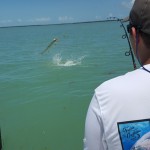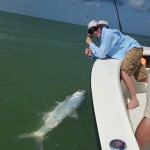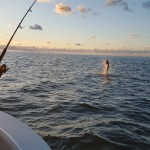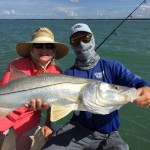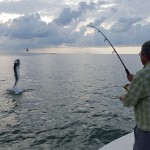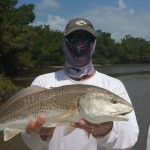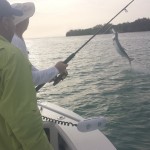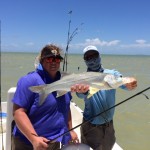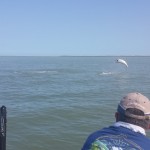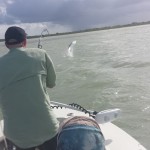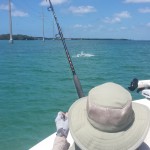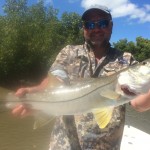September is winding down though it has given me a welcomed break from fishing every day. It is always our slowest month of the year. Thankfully though as I mentioned it is a welcome one, a time to catch my breath and take care of all the things in life you can’t get to when you are so busy. Anyways fishing can still be good this time of year it is just slow on the business side of things – with kids going back to school, hunting seasons opening everywhere, the possibilities of hurricanes (though unlikely), and the heat – all seem to keep it quiet here for the month. Anyhow I have been getting out a couple days a week. I’m not currently running my SeaCraft as it is getting some repair work done, but I am running a smaller action craft skiff. I’ve still had the majority of my customers asking for tarpon and there have still been a few around. It hasn’t been red hot action every day, though we have caught them just about every day we fished for them I think with exception to one. A few days we had multiple shots and were able to land a couple fish, the others it was only a single shot but we got one. Bait was fairly plentiful on the incoming tides in the backcountry, the falling tides it was a little tougher though we had gotten lucky a couple times and found some big schools of mullet in the gulf. The sharks had been few and far between, though after the hard rains last week with the water cooling down about 10 degrees we did have some good shark action while tarpon fishing which was nice. It is always nice to have that filler in between while waiting for a tarpon bite. In the near-gulf bays the snapper fishing has been really good I’ve been chunking up mullet or ballyhoo and catching some big snappers. This has been the best bet for action/rod bending, and there are big ladyfish and a few trout mixed in too. This is not as tidal related and can be good into the Fall. Snook and redfish have been around though honestly I haven’t done much of it as the bugs have been horrendous with all the rain we had, plus it has been difficult to find any good size pilchards. My future forecast for October is… [sociallocker id=”692″] looking pretty good! October is one of my favorite months to fish down here in Islamorada with the start of cooler weather coming our way. We usually get a week or two of insane fishing with the ‘fall bait run.’ There is no way to tell when this will occur but when we start getting some northerly breezes it will push hordes of baitfish down the coast and the big predators follow right along. Big tarpon, sharks, snook, redfish, and everything… When the bait run occurs, sometimes you can see hundreds of tarpon in an area busting on all kinds of baitfish, it is pretty spectacular. Anyhow even if that is not occurring it can still be good fishing. Tarpon are definitely still a possibility then too but it may not be the insane show that the bait run brings. I will start to focus more on catching smaller whitebait (pilchards) and the snook/redfish fishing. With the cooler temperatures look for those fish to push out of the skinny water flats into the island moats, shorelines, and creeks where we fish in the Fall. Other options are the gulf as spanish mackerel can sometimes make an early arrival, plus there are tripletail out there and cobias on the deeper wrecks. Anyways the point is October ca be very good fishing, business is still fairly slow so you can often have the backcountry to yourself with very good fishing to boot. Drop me a line if you are looking to go out![/sociallocker]
8/20/15 August Islamorada Fishing Report
August is winding down and we are getting into our ‘slow’ season here. I’ve been lucky and still filling in many days with last minute bookings though as we get into September it will be time to relax. I have a trip to the Bahamas planned (hopefully) if hurricane Danny doesn’t have anything to say about it! As far as fishing goes things have been decent I’ve been mostly tarpon fishing still doing the early morning drill in the everglades. Bait has been a little tough to come by some days, on the incoming tides it has been much easier. Fishing has been OK overall we’ve had some big days with multiple fish landed, and some days with only a bite or two and lucky to catch one. In the last couple weeks we had a few 4 tarpon days, one day with 6 landed, and a couple others with 3. The last few days has been a lot tougher we only had 3 bites in the last 2 trips, but we did manage to catch one on each trip. The backcountry channels have been holding a handful of fish though they are moving around so it’s trial and error trying to hit them early in the mornings. Later on off the beaches to the west near the gulf had been a little more consistent finding schools of tarpon out there, however a couple days it has been a ghost town and the next day they will be all over the place. Though it is getting late in the year so it is not uncommon you just have to put your time in. Sharks have been mixed in including plenty of blacktips, some big lemons, and occasionally some others like hammerheads or bulls. I haven’t done a lot of snook fishing the last few weeks though the last few days I did earlier in the month we had some success. Not a lot of big pilchards around but pinfish did the trick and we had several good days with multiple snook caught each of those days. In the gulf bays there have been some good sized mangrove snappers and hanging the chum bag you can usually catch some ballyhoo or something to use for cut bait to get them. A few trout have been mixed in too. That’s my report as I said September is definitely our quietest month of the year as far as business goes, but that doesn’t mean the fishing isn’t good. Actually since not too many boats are out you can often feel like you have the entire backcountry to yourself and don’t have to worry about boats being ‘in your spot.’ If you are thinking of coming down drop me a line it usually won’t be a problem to set something up short notice. October is right around the corner and that is usually very good fishing as things cool off a little bit and we start to get the fall bait run. That can be some of the best tarpon fishing of the year and also really good for redfish, snook, trout, and other specimens.
7/21/15 July Islamorada Fishing Report for the backcountry
We are mid way through July and it is really feeling like summer with the heat. But luckily the fishing has been just as hot too! Actually it has not been too brutal we have had light breezes just about every day which makes a huge difference, plus I like to get our early before daybreak to beat the afternoon heat. I’ve been mostly tarpon fishing still and that has been really good. Consistent would be the best way to describe it and the bait and fish patterns have stayed that way with the relatively calm winds and stable conditions. Mullet have not been super easy to catch every day, but we’ve been finding them and some days you just have to work a little harder at it. The tarpon have been in the backcountry channels and hitting them early morning has worked well for me the last several weeks. In the afternoons I’ve been finding some off the beaches of the mainland and those fish can bite just about any time of day, on any tide. Some days have only yielded a bite or two, but on the good days we’ve landed multiple fish with up to a half dozen hookups. Other than tarpon I’ve been having good luck with snapper and trout in the bays of the near gulf. I’ve also been doing some snook fishing and that has been a lot of fun. Finding the right bait for them is key to get ‘hot snook action’ which means trying to catch pilchards. They aren’t always able to be found but pinfish will suffice and you can still pick away at the snook and redfish with those. Out in the gulf there have been a few tripletail floating around, though with the crab and lobster pots gone not much structure for them to hang on so you have to get lucky and see them floating, or have them drift by you while you are tarpon fishing. Permit are a definite possibility too I haven’t really tried the wrecks lately but I have seen a few randomly on some closer inshore spots in the everglades. Fishing is really good and it is one of my favorite times of year as the crowds are gone and you have the place to yourself. This will remain the next several months. August can be a very good time to fish and I’ve already started filling in some days with customers who have experienced this the last few years with me. Get in touch with me and lets go fishing!
6/29/15 June Islamorada Fishing Report
June has come and gone very fast. We got into ‘summer time’ mode here a little early this year it seemed. Just about all of June and even late May I was mostly fishing in the everglades for tarpon. There were steady numbers of fish back there, plus the bait was much easier to get most days. Our spring mullet run had come to an abrupt halt near Islamorada – we really didn’t have a great year for bait at all there. Though the nice thing about Islamorada is you have pretty close access to the everglades which is an entirely different fishing experience. The last month or so I’ve been hitting many of the open water areas of the near gulf where schools of tarpon have been coming in for the summer. These late arrivals are often smaller male fish, many of the larger female tarpon have already moved up the coast. Though there is still the occasional straggler. As a matter of fact a week or so ago we caught a 150 lber that dragged us about 4 miles up the beach and we fought for 2.5 hours! Most days have yielded anywhere from 2 to 6 bites, and we’ve been averaging landing 2 a trip which is pretty good for tarpon fishing. My best day this year actually was a couple weeks ago, we were able to hook and land 7. So all in all the summer time tarpon bite has been very good and it is definitely not too late to catch them, this fishing can be very good all the way through August (which was the case the last couple years). It does require usually a 3/4 or full day, and I like to leave early to catch the bait and get in on the better fishing. Other than that I’ve been doing some trout and snapper fishing out to the western edge of the gulf. There has been some very nice size trout and mixed in are plenty of snappers and ladyfish. The small ballyhoo are readily available and we often catch those and use them for bait, though artificial GULP has been doing the trick too. I’ve also been doing a fair amount of snook fishing and that has been good for the most part too. Live bait is key for that and pilchards and pinfish are able to be caught most days while trout/snapper fishing, then we usually try a snook spot or two on the way home. Most days we’ve caught at least a few and up to a dozen. Plenty of sharks are around too including blacktips, lemons, hammerheads, and the occasional bull. From here on out I’ll still be tarpon fishing the majority of the time. July is slowly filling up though I will definitely have some days open short notice. If your looking to catch a tarpon this is still a good time, plus with the other variety of fish it can be a very productive day. Summer is nice because the winds are generally calm and weather patterns stay the same, so the fish aren’t moving around quite as much and much less pressure on them. Drop me a line lets get out fishing!
5/21/15 May Backcountry Fishing Report
May is rolling by fast and I’ve been fishing every day. Overall the fishing has been pretty good. We had a little lull in early May with the tarpon fishing. We had some late cold weather in April with some high winds and things turned off to start May, then we had flat calm weather following the full moon. Plenty of tarpon around though they weren’t feeding very well. Though mid May the bite has gotten much better, though now the fish seem to be much more on the move. Where a big school of fish will be one day, they are gone the next. So you must put your time in and fish hard and move around. We’ve had some big days with good numbers caught, and lots of days with only a few shots at fish. I have not been fishing many nights this year as I had mostly full day trips booked and not trying to burn myself out. Though the last couple weeks the evening bite has been a bit more dependable overall and tarpon are starting to feed on crabs well on the falling tides in the late afternoon/evenings. I’ve been having some good luck in the backcountry with smaller tarpon and plenty of sharks back there, yesterday we landed 4 nice tarpon which was a great day. We also had a good day with about a dozen snook and plenty of trout, snappers, a redfish, and 1 out of 2 tarpon for the ‘SLAM.’ The gulf has held some tripletails though honestly I have not been out there much as I have had mostly people looking for tarpon plus we did have some real windy weather for a good portion of May, not ideal for the open water of the gulf. As we get into June we get to some of my favorite fishing of the year. The early morning trips to the everglades yield a very dependable fishery for tarpon. Also bait is fairly easy to catch back there too. The last few years we were also able to chum pilchards up on many days and had good snook fishing in the afternoons. This can last through August. If your thinking of coming down this summer drop me a line, July and August is some of the best fishing we have all year again because the weather is stable and the early mornings you can be the heat.








